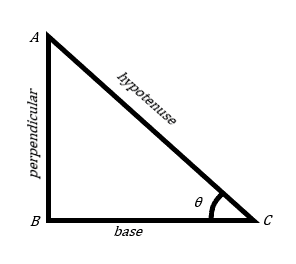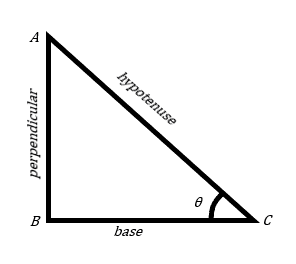
How do you find the exact values of \[\cos \theta \] and \[\sin \theta \] when\[\tan \theta =\dfrac{5}{12}\]?
Answer
529.8k+ views
Hint: The given question is the trigonometric expression and in order to solve this solve we have to use the properties of trigonometric functions. First we need to get the relation of sine, cosine and the tangent function. We have given the value of tan function, then by using Pythagoras theorem we will find the value of hypotenuse. Later putting the value for each trigonometric function, we will get the required exact values.
Formula used:
To find the tangent of any angle we need to just divide the sine and cosine of the same angle:\[\tan \theta =\dfrac{\sin \theta }{\cos \theta }=\dfrac{perpendicular}{base}\]

Complete step by step solution:
We have given that,
\[\tan \theta =\dfrac{5}{12}\]
As we know that,
The tangent of any angle we need to just divide the sine and cosine of the same angle:\[\tan \theta =\dfrac{\sin \theta }{\cos \theta }=\dfrac{perpendicular}{base}\]

We know that:
\[\tan \theta =\dfrac{\sin \theta }{\cos \theta }\], where
\[\sin \theta =\dfrac{perpendicular}{hypotenuse}\]
\[\cos \theta =\dfrac{base}{hypotenuse}\]
Now if we divide \[\sin \theta \] by \[\cos \theta \],, we will get
\[\dfrac{\sin \theta }{\cos \theta }=\dfrac{\dfrac{perpendicular}{hypotenuse}}{\dfrac{base}{hypotenuse}}=\dfrac{perndicular}{base}=\tan \theta \]\[\]
Hence we get the relation between sin, cos and tan.
Therefore,
We have given the following function, i.e.
\[\tan \theta =\dfrac{5}{12}\]
Thus,
\[\tan \theta =\dfrac{5}{12}=\dfrac{perpendicular\ side}{base\ side}\]
By using the Pythagoras theorem;
\[hypotenuse=\sqrt{{{\left( base\ side \right)}^{2}}+{{\left( perpendicular\ side \right)}^{2}}}\]
Therefore,
Hypotenuse = \[\sqrt{{{5}^{2}}+{{12}^{2}}}=\sqrt{25+144}=\sqrt{169}\]
The \[\sqrt{169}\] is equal to 13,
Thus hypotenuse = 13.
Now, putting the value.
Therefore, we have
\[\Rightarrow \sin \theta =\dfrac{perpendicular}{hypotenuse}=\dfrac{5}{13}\]
\[\Rightarrow \cos \theta =\dfrac{base}{hypotenuse}=\dfrac{12}{13}\]
Hence, it is the required possible answer.
Note: In order to solve these types of questions, you should always need to remember the properties of trigonometric and the trigonometric ratios as well. It will make questions easier to solve. It is preferred that while solving these types of questions we should carefully examine the pattern of the given function and then you would apply the formulas according to the pattern observed. As if you directly apply the formula it will create confusion ahead and we will get the wrong answer.
Formula used:
To find the tangent of any angle we need to just divide the sine and cosine of the same angle:\[\tan \theta =\dfrac{\sin \theta }{\cos \theta }=\dfrac{perpendicular}{base}\]

Complete step by step solution:
We have given that,
\[\tan \theta =\dfrac{5}{12}\]
As we know that,
The tangent of any angle we need to just divide the sine and cosine of the same angle:\[\tan \theta =\dfrac{\sin \theta }{\cos \theta }=\dfrac{perpendicular}{base}\]

We know that:
\[\tan \theta =\dfrac{\sin \theta }{\cos \theta }\], where
\[\sin \theta =\dfrac{perpendicular}{hypotenuse}\]
\[\cos \theta =\dfrac{base}{hypotenuse}\]
Now if we divide \[\sin \theta \] by \[\cos \theta \],, we will get
\[\dfrac{\sin \theta }{\cos \theta }=\dfrac{\dfrac{perpendicular}{hypotenuse}}{\dfrac{base}{hypotenuse}}=\dfrac{perndicular}{base}=\tan \theta \]\[\]
Hence we get the relation between sin, cos and tan.
Therefore,
We have given the following function, i.e.
\[\tan \theta =\dfrac{5}{12}\]
Thus,
\[\tan \theta =\dfrac{5}{12}=\dfrac{perpendicular\ side}{base\ side}\]
By using the Pythagoras theorem;
\[hypotenuse=\sqrt{{{\left( base\ side \right)}^{2}}+{{\left( perpendicular\ side \right)}^{2}}}\]
Therefore,
Hypotenuse = \[\sqrt{{{5}^{2}}+{{12}^{2}}}=\sqrt{25+144}=\sqrt{169}\]
The \[\sqrt{169}\] is equal to 13,
Thus hypotenuse = 13.
Now, putting the value.
Therefore, we have
\[\Rightarrow \sin \theta =\dfrac{perpendicular}{hypotenuse}=\dfrac{5}{13}\]
\[\Rightarrow \cos \theta =\dfrac{base}{hypotenuse}=\dfrac{12}{13}\]
Hence, it is the required possible answer.
Note: In order to solve these types of questions, you should always need to remember the properties of trigonometric and the trigonometric ratios as well. It will make questions easier to solve. It is preferred that while solving these types of questions we should carefully examine the pattern of the given function and then you would apply the formulas according to the pattern observed. As if you directly apply the formula it will create confusion ahead and we will get the wrong answer.
Recently Updated Pages
Two men on either side of the cliff 90m height observe class 10 maths CBSE

What happens to glucose which enters nephron along class 10 biology CBSE

Cutting of the Chinese melon means A The business and class 10 social science CBSE

Write a dialogue with at least ten utterances between class 10 english CBSE

Show an aquatic food chain using the following organisms class 10 biology CBSE

A circle is inscribed in an equilateral triangle and class 10 maths CBSE

Trending doubts
Why is there a time difference of about 5 hours between class 10 social science CBSE

Write a letter to the principal requesting him to grant class 10 english CBSE

What is the median of the first 10 natural numbers class 10 maths CBSE

The Equation xxx + 2 is Satisfied when x is Equal to Class 10 Maths

Which of the following does not have a fundamental class 10 physics CBSE

State and prove converse of BPT Basic Proportionality class 10 maths CBSE




